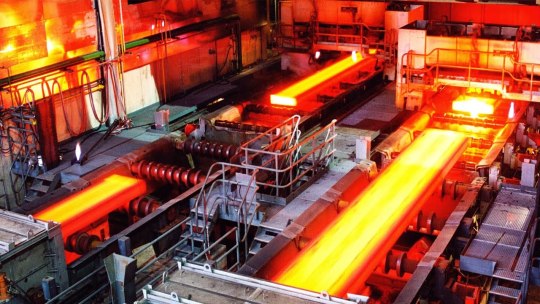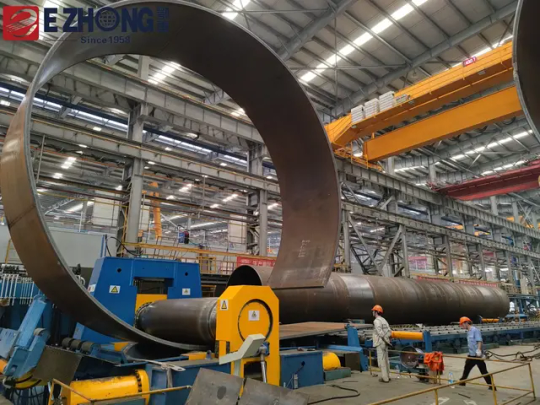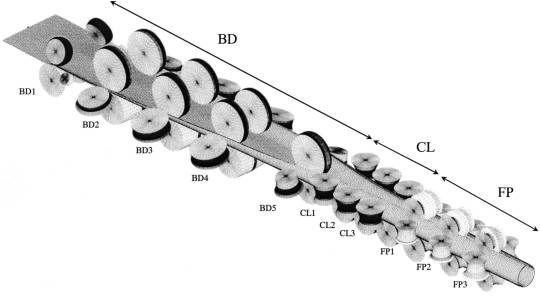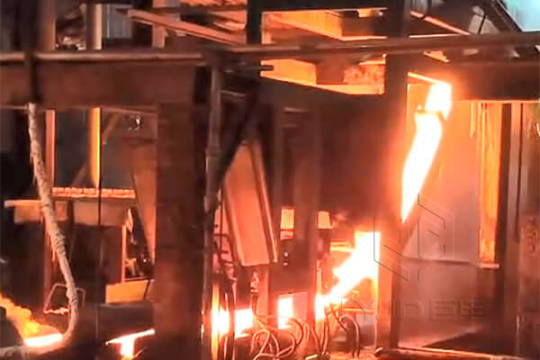#rolling mill
Text
Steel being an Alloy of Iron with carbon generally requires the carbon to be fairly uniform to improve ductility, and thus the fresh cast iron which has carbon distributed unevenly throughout it, in order to fix this you must work the iron to turn into steel, if it is lightly worked by hand like say a hammer an anvil you get wrought iron but to get your good modern steel you need to roll it with big ass rollers which can be done both hot or cold


22 notes
·
View notes
Text

rolling mill
44 notes
·
View notes
Photo

The new forming mill (FF mill) used for the study, Outline of New Forming Equipment for Hikari 24” ERW Mill, NIPPON STEEL TECHNICAL REPORT No. 90 July 2004
12 notes
·
View notes
Text
Differentiate between Hot rolling and Cold rolling
Hot Rolling
Hot rolling carried out to roll ingots into slabs,billets. On further hot rolling plates.l, bar rounds, structural shapes and rails are obtained. Because of limitations in equipment and workability if metal rolling is done is progressive steps.
Cold rolling:-
Cold rolling is a process used in manufacturing to shape metal sheets and strips. It involves passing the metal through a pair of rollers at room temperature, which compresses and elongates the material, reducing its thickness and altering its surface finish.
Read More
0 notes
Text
Steel mill machines
Iron production and steel production are vital processes in the modern industrial world, serving as foundational elements in construction, manufacturing, transportation, and various other sectors. Here are some key applications for both iron and steel:

Iron production applications:
put up:
Basically iron is widely used for building structural purposes. It is used in beams, columns and steel bars in concrete structures.
Machinery and Tools:
Of course, because iron is a key material for manufacturing machinery and equipment in various industries such as agricultural machinery, mining equipment and industrial machinery.
Cars:
Iron is widely used in the automotive industry to make engine blocks, cylinder heads, suspension components and other structural components.
Pipeline:
Iron pipes are commonly used to transport water, natural gas and oil.
household items:
Iron is widely used in a variety of household products, including appliances, utensils, and fixtures.
Steel production applications:
put up:
Its high strength-to-weight ratio makes it ideal for high-rise buildings and long-span structures.
car:
Steel is a key material in automobile manufacturing, used in body panels, chassis components, and safety features such as airbags and seat belt reinforcements.
Mechanical equipment:
Steel is the primary material used in the construction of heavy machinery, tools and equipment used in various industries including construction, agriculture, mining and manufacturing.
Packaging:
Likewise steel is used in packaging materials such as food and beverage cans, aerosol containers and chemical drums.
Energy sector:
Steel is used to build pipelines, storage tanks and offshore platforms for the oil and gas industry, as well as wind turbines and solar panels for renewable energy applications.
Household equipment:
Likewise due to its durability and corrosion resistance, steel is used in the manufacture of home appliances such as refrigerators, stoves, washing machines, and dishwashers.
Steel plays an integral role in modern society and is the backbone of infrastructure, manufacturing and everyday products. Their versatility, strength and durability make them important materials for a variety of applications.
#induction furnace#hot rolling mill#induction heating furnace#induction melting#rolling mills#rolling mill#aluminum#aluminum melting furnace#continuous casting machine#furnace
0 notes
Text
0 notes
Text
Oh, my God, this effect is too good.
Oh, my God, this effect is too good. Have you ever used the filter aid for rolling oil and Zhijing, the bosses who do metal processing? Look at this filtering effect. This dark rolling oil has been filtered twice by Zhijing, and this oil is actually clear! Great to use! Come and try it!
#aluminium foil#cold rolling#rolling mill#Rolling oil#metal processing#Aluminum plate processing#filter
1 note
·
View note
Text

0 notes
Text
The Repair Process of Gearbox on a Rolling Mill
The repairing process of various devices and tools will be different from each other. Some repairing systems are easy, while others can be too difficult and time-consuming. Unfortunately, the repairing process of a gearbox on a rolling mill is one of those complex repairing systems. According to a professional at GMB Heavy Industries, since gearboxes have essential roles in rolling mill functions and operations, fixing them as soon as possible is vital. There are various crucial steps in the repairing process of gearboxes.
Important Steps for Repairing Gearbox on a Rolling Mill
Like other repairing systems, in the first step, you need to recognize the root of the issue. So, at the beginning of the gearbox repair system, you have to identify the problem's source and then try to solve it as soon as possible.
The experts need to inspect and observe the gearbox condition to identify the factor and reason for the existing issue. Sometimes, the gearbox needs a repair process due to hard damage. In addition, experts need to improve the gearboxes because of their weird noises.
Note that overheating can be another main reason for repairing the gearbox. By searching on this tool, experts can easily find other signs of different flaws and deficiencies in the gearbox.
After identifying the issue's root, experts must be careful about safety precautions. They must be cautious before starting the repair system to prevent sudden problems. The area must be safe enough to start the repair system. Here are the most critical steps for repairing the gearbox process on the rolling mill.
Inspecting the Disassembling
The assembling section has an essential role in the correct function of the gearbox; therefore, the experts must inspect if there is any visible disassembling. They need to check different parts like gears, seals, and bearings.
Cleaning Different Parts
This step may seem too easy, but cleaning is also an important step in repairing the procedure of gearboxes. All sections must be as clean as possible without any lubricants on it.
Replacing and Reassembling Different Parts
As the name of this step shows, experts tend to replace damaged and unacceptable parts with the newest ones. Every component can be replaced. In this step, you must be careful in reassembling the aligned parts and contents of the gearbox.
Using the Proper Lubrication
As you know, lubricant is helpful for the gearbox movement. So, it is important to check the lubricant condition during the repair process.
Aligning and Testing the Components
This step is the best time for measuring and checking each part related to the rolling mill gearbox. After this step, experts demand to inspect or test the correct function of the gearbox. They try to see if the gearbox still has weird noises or overheating issues.
Starting the Functionality
After all these steps, it is time to use the gearbox in the operation system. Don’t forget to maintain this tool during the process because the gearbox needs a planned monitoring process.
Final Thought
Remember to check its lubricant and other parts in most cases. The operation history of this tool can be helpful to pass the repair process successfully. Never ignore any detailed and tiny issue within this tool because the gearbox is vital to the rolling mill.
0 notes
Text
ROLLING MILLS
Rolling mills are machines used in the metalworking industry to shape and reduce the thickness of metal sheets, strips, or bars through a series of rolling operations. They are a key component of the steelmaking and metal fabrication processes, enabling the production of various metal products with precise dimensions and desired mechanical properties. The primary function of a rolling mill is to apply pressure and reduce the thickness of a metal workpiece by passing it between a set of rotating rolls. The rolls exert compressive force on the material, causing it to deform and elongate. Rolling mills can vary in size and complexity, ranging from small manual mills to large automated mills used in industrial-scale production. It’s play a crucial role in the production of a wide range of metal products, including sheets, plates, bars, wires, tubes, and structural shapes. They are integral to industries such as construction, automotive, aerospace, energy, and manufacturing.
#manufacture#industrial equipment#manufacturer#metallurgical#metallographicequipments#metallurgicalmicroscopes#mill#rolling mills#rolling mills supplier#rolling mill#rolling mills manufacture#rolling mills supplier in india#rolling mills manufacture in india#rolling mills supplier in delhi#rolling mills manufacture in delhi#rolling mills supplier in uttar pradesh#rolling mills manufacture in uttar pradesh
1 note
·
View note
Text

hot rolled
17 notes
·
View notes
Photo

The former forming mill (cage roll forming mill) of NSC Hikari 24” ERW mill, Outline of New Forming Equipment for Hikari 24” ERW Mill, NIPPON STEEL TECHNICAL REPORT No. 90 July 2004
5 notes
·
View notes
Text
0 notes
Text
Casting production line
Generally speaking, a casting line is a manufacturing process in which molten metal is poured into a mold to create a solid object of the desired shape. Here is a simplified overview of how casting lines typically work:

· Model making:
However, the process begins with the creation of a model, which is a replica of the object that will eventually be cast. Patterns are usually made of wood, metal or plastic.
·Mold making:
Casts are used to make molds, usually made of sand, plaster, or metal. It consists of two halves, an upper mold (top) and a lower mold (bottom), which fit together to form a cavity in the shape of the desired object.
· Prepare the mold:
Before pouring molten metal, the mold cavity needs to be prepared. This may involve using a release agent to prevent sticking, assembling the core (used to create internal features) if necessary, and venting the mold to allow gases to escape.
· Melting and Pouring:
The metal is melted at high temperatures in a furnace and poured into the mold cavity through a gating system that includes channels and runners designed to deliver the metal into the mold efficiently and without turbulence.
·Cure:
Basically after pouring, the molten metal begins to solidify in the mold cavity. The time required to solidify depends on factors such as metal type, temperature, and casting design.
· Cooling and demoulding:
After the metal solidifies, the mold can be further cooled to ensure that the casting is completely solidified. Then, open the mold and remove the casting.
· QC:
This may involve visual inspection, measurement and non-destructive testing techniques.
Finally, throughout the production line, efficiency, safety and quality are paramount considerations to ensure that castings always meet the required standards.
0 notes
Text
Top Alloy Steel Rolling Mill Plant Manufacturer Company in India-Steewo Engineers

Steewo Engineers stands tall as one of the premier Alloy Steel Rolling Mill Plant Manufacturer Company in India. With a rich history, cutting-edge technology, and a commitment to excellence, Steewo Engineers has established itself as a leader in the industry.
History and Background of Steewo Engineers
Steewo Engineers & Consultants Pvt Ltd. is a leading rolling mill manufacturer in India, based in Jaipur since 2013. We provide tailored solutions for Rebar mills, section rolling mills, and strip rolling mills, with meticulous craftsmanship and advanced technology. Our professional management ensures top-tier machinery, systems, and services, supported by stringent quality checks and non-destructive testing. We emphasize premium raw materials and offer refurbishment services and replacement parts for various mills and equipment.
Also Read: Medium Hot Strip Rolling Mill Plant Manufacturer Company in India-Steewo Engineers
Products Offered by Steewo Engineers
Steewo Engineers offers a comprehensive range of products, including rolling mill plants, TMT quenching boxes, and gears and gearboxes. Each product is crafted with precision and engineered to deliver exceptional performance.
Quality Standards and Certifications
At Steewo Engineers, quality is paramount. The company adheres to stringent quality standards and holds various certifications, ensuring that every product meets the highest industry benchmarks.
Source Url:
0 notes